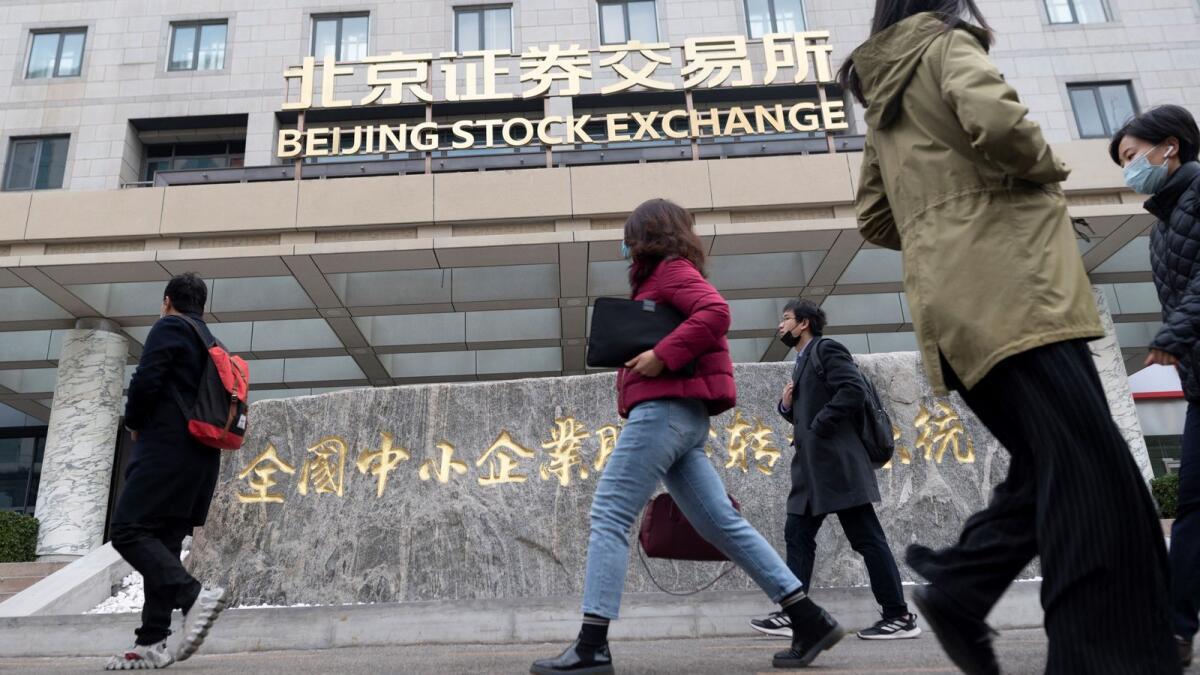
China Hurries To Shore Up Sliding Yuan And Stock Markets
With two weeks before Trump begins a second US presidency, his threats of big tariffs on Chinese imports have rattled the yuan, driven mainland bond yields down and got stocks off to a rough start to 2025.
On Monday, China's tightly controlled yuan weakened to its lowest in 16 months while the blue-chip stock index touched its weakest since the end of September, slipping as much as 0.9 per cent on the day before closing down 0.2 per cent. The index fell five per cent last week to clock its biggest weekly loss in more than two years.
China's stock exchanges asked large mutual funds to restrict their selling of stocks at the beginning of the year, three sources familiar with the matter told Reuters, underscoring the jittery mood in the market.
At least four large mutual funds received calls from the Shanghai and Shenzhen stock exchanges on December 31 and January 2 and 3, asking them to ensure they bought more stocks than they sold each day, the sources said.
The Shanghai and Shenzhen stock exchanges recently met with foreign institutions, both bourses said on Sunday, assuring investors they would continue to open up China's capital markets.
The People's Bank of China could issue more yuan bills in Hong Kong in January, state-owned news outlet Yicai reported on Monday, in a sign authorities want to absorb currency to dampen speculation. Financial News, a central bank publication, said the PBOC has the tools and the experience to react to yuan depreciation.
“Preventing a sharp decline of the yuan will be crucial for China's recovery,” said Charu Chanana, chief investment strategist at Saxo.“Any tactical recovery this year will need more than just stimulus measures, particularly whether China can negotiate a deal with President-elect Trump.”
The world's second-biggest economy has struggled over the past few years as a property downturn and slowing income sapped consumer demand and hurt businesses. Exports were one of the few bright spots, but could face hefty US tariffs under a second Trump administration.
The S&P 500 has risen four per cent while China's CSI300 index has dropped 4.3 per cent since the US election in early November, highlighting the worries around tariffs. European stocks are flat in the same period.
Yuan pressure
Chinese authorities have introduced various support measures since September, including swap and relending schemes totalling 800 billion yuan ($109 billion), to shore up investor confidence and put a floor under stocks.
The yuan has routinely hit multi-month lows since Trump won the US election as the threat of tariffs along with worries about China's sluggish economic recovery triggered capital outflows.
The spot yuan hit 7.3301 per US dollar on Monday, its weakest since September 2023, after breaching the key threshold of 7.3 per dollar for the first time since 2023 on Friday.
The yuan declined 2.8 per cent against the dollar in 2024, its third annual decline, reflecting most currencies' struggle against a strong dollar.
Despite China's efforts to stall the yuan's decline via the daily benchmarks it sets, falling domestic yields and broad dollar strength have undercut their efforts.
China's FX reserves at $3.3 trillion may have some buffer for capital outflows, although deprecation and outflow would be negative for China's equity market sentiment, BofA strategists said in a note.
“Geopolitical tensions and potential US policies ... could lead to higher cost of capital and multiple de-rating again in 2025. That said, we believe the worst of flow/position-selling for the China market should have been over,” they said.
The central bank on Friday warned fund managers against pushing bond yields even lower, amid worries that a bubble in bonds might stymie Beijing's efforts to revive growth and manage the yuan.
In a sign of bearishness on the economy and deeply entrenched deflationary pressures, the yields on short-term bonds, with maturities of 7 years or less, are trading below the policy rate, the seven-day reverse repo rate. Long-term yields are at record lows.
“While Chinese officials have promised further stimulus, signalling greater monetary and fiscal easing, investors are waiting for concrete signs that demand is responding,” HSBC's chief Asia economist Fred Neumann said.
“After many fits and starts over the past year, greater evidence is needed that China's economy is responding to stabilisation measures,” Neumann said.
A key test for consumer confidence will be the impending Lunar New Year celebrations, which start on January 29, he said.

Legal Disclaimer:
MENAFN provides the
information “as is” without warranty of any kind. We do not accept
any responsibility or liability for the accuracy, content, images,
videos, licenses, completeness, legality, or reliability of the information
contained in this article. If you have any complaints or copyright
issues related to this article, kindly contact the provider above.


















Comments
No comment